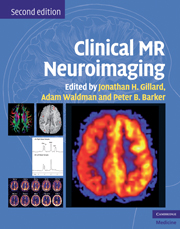Book contents
- Frontmatter
- Contents
- Contributors
- Case studies
- Preface to the second edition
- Preface to the first edition
- Abbreviations
- Introduction
- Section 1 Physiological MR techniques
- Section 2 Cerebrovascular disease
- Section 3 Adult neoplasia
- Section 4 Infection, inflammation and demyelination
- Section 5 Seizure disorders
- Section 6 Psychiatric and neurodegenerative diseases
- Section 7 Trauma
- Section 8 Pediatrics
- Chapter 46 Physiological MR of the pediatric brain
- Chapter 47 Physiological MR imaging of normal development and developmental delay
- Chapter 48 Magnetic resonance spectroscopy in hypoxic brain injury
- Chapter 49 The role of diffusion- and perfusion-weighted brain imaging in neonatology
- Chapter 50 Physiological MR of pediatric brain tumors
- Chapter 51 Physiological MR imaging techniques and pediatric stroke
- Chapter 52 Magnetic resonance spectroscopy in pediatric white matter disease
- Chapter 53 Magnetic resonance spectroscopy of inborn errors of metabolism
- Chapter 54 Pediatric trauma
- Section 9 The spine
- Index
- References
Chapter 51 - Physiological MR imaging techniques and pediatric stroke
from Section 8 - Pediatrics
Published online by Cambridge University Press: 05 March 2013
- Frontmatter
- Contents
- Contributors
- Case studies
- Preface to the second edition
- Preface to the first edition
- Abbreviations
- Introduction
- Section 1 Physiological MR techniques
- Section 2 Cerebrovascular disease
- Section 3 Adult neoplasia
- Section 4 Infection, inflammation and demyelination
- Section 5 Seizure disorders
- Section 6 Psychiatric and neurodegenerative diseases
- Section 7 Trauma
- Section 8 Pediatrics
- Chapter 46 Physiological MR of the pediatric brain
- Chapter 47 Physiological MR imaging of normal development and developmental delay
- Chapter 48 Magnetic resonance spectroscopy in hypoxic brain injury
- Chapter 49 The role of diffusion- and perfusion-weighted brain imaging in neonatology
- Chapter 50 Physiological MR of pediatric brain tumors
- Chapter 51 Physiological MR imaging techniques and pediatric stroke
- Chapter 52 Magnetic resonance spectroscopy in pediatric white matter disease
- Chapter 53 Magnetic resonance spectroscopy of inborn errors of metabolism
- Chapter 54 Pediatric trauma
- Section 9 The spine
- Index
- References
Summary
Introduction
Stroke is an important and under-recognized disorder in children and is one of the top 10 causes of childhood death.[1] Arterial ischemic stroke affects around 8 of 100 000 children annually. Up to a quarter of these children will have a recurrence and two-thirds have long-term disability directly attributable to stroke.[2] Many advances in the understanding of childhood stroke have arisen from the insights available from modern imaging techniques, in particular from MR imaging (MRI). The aims of conventional MRI are not only to detect the infarct but also to provide information to establish the cause of the stroke and to exclude other causes (such as tumor). Clinical applications of physiological MRI techniques (MR diffusion imaging [DWI], MR perfusion imaging, and MR spectroscopy [MRS]) in this group of patients are still largely in the research domain. This chapter will consider arterial ischemic stroke (henceforth abbreviated as stroke) in children over 1 month of age.
There are some important differences in stroke etiology between adults and children. Around half of the children affected by stroke will have another recognized medical condition, most commonly sickle cell disease (SCD) or congenital heart disease. Consequently, many children may have dual pathologies on imaging, as well as factors that may influence the interpretation of physiological MRI (e.g., chronic hypoxia or polycythemia). Rather than having a single identified etiology, the majority of children with stroke will have a combination of multiple risk factors. As well as those already mentioned, other important risk factors for stroke in children are anemia (which is found in up to 40%), prothrombotic disorders, and infections such as varicella zoster virus.[3]
- Type
- Chapter
- Information
- Clinical MR NeuroimagingPhysiological and Functional Techniques, pp. 784 - 805Publisher: Cambridge University PressPrint publication year: 2009

